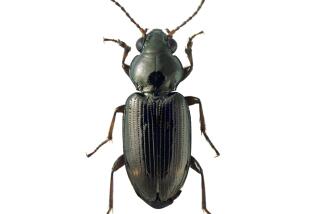New crypt-keeping beetle species discovered on Pacific island
- Share via
Scientists have discovered a new species of beetle that buries bird and mammal carcasses in a crypt for its young to eat, according to a new study.
Sporting sickle-like jaws and front wings that reach like a black-and-red leather miniskirt partway down the length of its abdomen, the beetle would look at home in an episode of “Tales from the Crypt.”
Tonya Mousseau came across a set of six beetles collected during the 1960s, perfectly preserved and mounted on pins in Hawaii’s Bishop Museum. They looked different from the rest of the specimens she had seen from the Solomon Islands, a thousand-island archipelago in the western Pacific.
She immediately suspected she had stumbled on to something new, said Derek Sikes, Mousseau’s dissertation advisor and coauthor on the study.
Upon closer examination, the pair realized they had discovered a new species, which they named Nicrophorus efferens from the Latin verb effero, meaning “to carry out for burial.” The primary difference between it and its closest relative was the “elytra microsculpturing,” bug-nerd-speak for the pattern of the front wings. In other words, differently patterned miniskirts.
The new species is part of a larger family of 200-odd (and they are truly odd) beetles called burying beetles. Sikes, the curator of entomology at the University of Alaska Museum, is one of a handful of worldwide experts of the group.
Despite their small size -- N. efferens averages about 5.5 millimeters in length -- these beetles think big when it comes time to chow. They use their clubbed antennae, resembling a pair of field-hockey sticks, to find fresh carcasses of birds or small mammals. If a single male finds a carcass, he’ll use pheromones to signal for a female. If the corpse is a group discovery, a battle royal ensues, with males fighting males and females fighting females.
“Being big is the only way to win,” Sikes explained.
Once victorious, the largest male and female pair up and set about burying the carcass while stripping away its fur or feathers. While building their crypt, they douse the now-exposed flesh with anal and oral secretions that delay rotting, keeping critters with a dead-fetish at bay.
The male has a pair of files on its abdomen that it rubs together to make noise, much as crickets do. If it hits the right notes, it entices the female into mating, Sikes said.
Once the crypt housing the carcass is fully built, the female lays eggs in the soil around it. She always lays more eggs than the carcass can support in case a few don’t make it. However, if they all survive, she and her mate turn the extra larvae into dessert, according to Sikes.
Burying beetles are one of the few groups of beetles in which both the male and female take care of their young. The male sticks around in order to ensure that he never ends up on Maury Povich’s show and to fight off any lingering males who would otherwise invade the crypt, kill the larvae and sow their seed with the female.
Though the new species of burying beetle discovered by Sikes and Mousseau has never been observed alive by scientists, it likely behaves in much the same way as its necrophiliac relatives. All six known specimens of the species were collected on Bougainville Island in the Solomon Islands.
Given the enormous number of insect specimens collected during scientific expeditions, it’s not unusual to discover new species sitting on the shelves of museums, according to Peter Oboyski, senior museum scientist at UC Berkeley’s Essig Museum of Entomology.
“It’s not hard to find a new species. What’s really hard is knowing that it’s new,” Oboyski said.
“You need to have large museum collections to compare your specimens to, you need to borrow specimens from other museums, and you need the experts who know how to tell that something is new.”
Return to Science Now.
Twitter/@BradBalukjian






